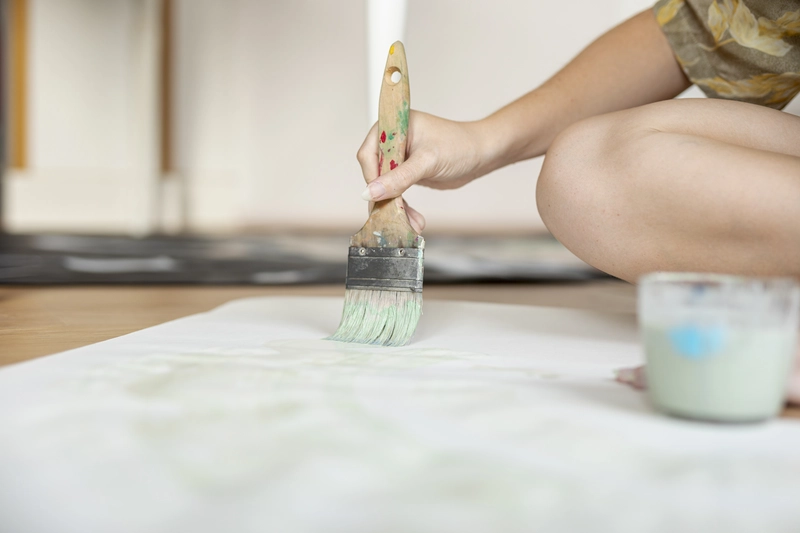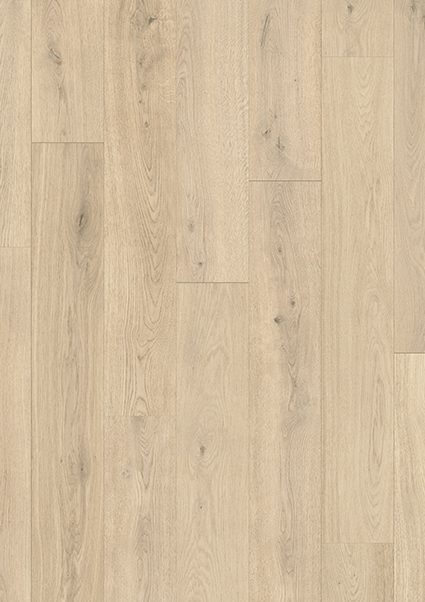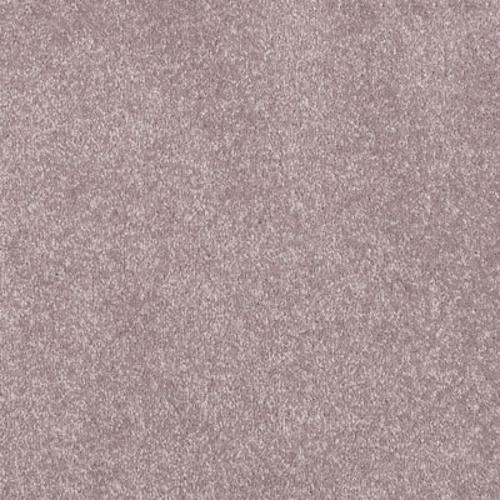Are you looking to give your laminate flooring a new look and wondering can you stain laminate flooring or not to achieve a different aesthetic? In this article, we will explore the world of laminate flooring, its benefits, types, and most importantly, whether or not you can stain it.
We will also provide you with a step-by-step guide on how to stain laminate flooring and offer some tips and alternatives to consider. So, let’s dive in and revamp your laminate flooring in style!
Staining Laminate Flooring
Can you stain laminate flooring? Actually, staining laminate flooring can be a challenging task due to the durable and synthetic top layer that is designed to resist damage and maintain a glossy finish, making it different from natural wood flooring.
The synthetic top layer of laminate flooring makes it difficult for traditional stain products to penetrate and bond effectively. This can result in uneven colouring or the stain not adhering properly, leading to a patchy or blotchy appearance. The smooth surface of laminate flooring can make it hard for stains to set evenly, creating a marred finish.
Painting laminate flooring is often considered as a viable alternative to staining. Proper preparation is essential to ensure adhesion. Cleaning the surface thoroughly, sanding lightly to create a rough texture for better paint adhesion, and priming with a suitable primer are crucial steps before applying paint.
What Is Laminate Flooring?
Laminate flooring is a versatile and cost-effective flooring option made from composite materials, featuring a top layer designed to mimic the appearance of real wood whilst providing enhanced durability.
The Benefits Of Laminate Flooring
One of the main benefits of laminate flooring is its durability and ease of maintenance, thanks to its hard surface and protective finish.
Laminate flooring is known for its ease of installation, making it a popular choice for DIY enthusiasts or those looking to save on installation costs. Its affordability compared to hardwood or stone flooring options also appeals to budget-conscious homeowners. The wide variety of styles and designs available in laminate flooring allows homeowners to find the perfect fit for their space, whether they prefer a sleek modern look or a more rustic feel. Laminate flooring is also highly resistant to scratches and stains, ensuring long-lasting beauty with minimal effort in upkeep.
The Types Of Laminate Flooring
Laminate flooring comes in several types, each with unique manufacturing processes and characteristics, including high-pressure laminate, direct-pressure laminate, and continuously pressed laminate.
a. High-Pressure Laminate
High-pressure laminate (HPL) is known for its exceptional durability and strong top layer that can withstand heavy use and retain its finish over time.
During the manufacturing process of HPL, multiple layers of kraft paper soaked in resin are pressed together under high heat and pressure. This results in a dense, hard-wearing surface that is resistant to scratches, impact, and moisture.
HPL finds versatile applications in residential and commercial settings, including kitchens, bathrooms, offices, and retail spaces due to its excellent performance and aesthetic appeal.
Compared to traditional laminate flooring, HPL offers enhanced durability and longevity, making it a preferred choice for high-traffic areas. Its top layer is made of multiple sheets of decorative paper saturated with resin, which gives it a realistic appearance that mimics natural materials such as wood or stone.
b. Direct Pressure Laminate
Direct pressure laminate (DPL) is an affordable option that is widely used in residential construction due to its cost-effectiveness and decent surface quality.
In the production process of DPL, the materials are assembled together and pressed under high heat and pressure to create a durable laminate flooring product. This process involves bonding several layers, including a core layer, a decorative layer, and a protective wear layer, which contributes to its durability and longevity.
DPL is commonly used for flooring in residential applications such as living rooms, bedrooms, and kitchens. Its affordability makes it an attractive option for homeowners looking to upgrade their floors without breaking the bank.
Compared to high-pressure laminate (HPL), DPL is more budget-friendly but may not offer the same level of durability and resistance to moisture and wear. While DPL is easier to install and cost-effective, it may not withstand heavy foot traffic or extreme conditions as well as HPL.
c. Continuously Pressed Laminate
Continuously pressed laminate (CPL) is created through a continuous production process that results in a consistent and uniform finish, often used for commercial applications.
This process involves feeding layers of materials through a series of rollers and presses, applying heat and pressure to bond them together seamlessly. The result is a durable product with a smooth surface that closely resembles real wood or stone finishes. The benefits of CPL include its scratch and impact resistance, making it ideal for high-traffic areas in both residential and commercial spaces.
How To Stain Laminate Flooring
Staining laminate flooring requires a careful approach that involves several steps:
- Preparing the surface
- Choosing the right stain
- Applying a primer
- Sealing the finish to ensure long-lasting results
1. Prepare The Laminate Flooring
The first step in preparing laminate flooring for staining is to thoroughly clean the surface and lightly sand it to create a texture that can hold the stain.
Effective cleaning is essential as any dust or debris left on the surface can interfere with the staining process. To clean, you can use a gentle cleaner or a mixture of water and vinegar to remove any dirt and grime. After cleaning, make sure to let the surface dry completely before proceeding to sanding.
Sanding plays a crucial role in ensuring the stain adheres properly to the flooring. Use fine-grit sandpaper to lightly sand the surface in the direction of the grain. This helps to roughen up the surface slightly, allowing the stain to penetrate more effectively.
2. Choose The Right Stain
Choosing the right stain for laminate flooring involves selecting a colour that complements your decor and a type that can adhere to the synthetic surface of the flooring.
Regarding types of stains, there are various options to consider. Epoxy paint is a popular choice for its durability and resistance to water and chemicals, making it ideal for high-traffic areas. On the other hand, polyurethane paint offers a smoother finish and is known for its scratch resistance. Before applying any stain, ensure that the surface is clean and free of any debris.
When choosing a colour, consider the overall aesthetic of your space. Lighter stains can make a room feel more spacious, while darker stains add warmth and cosiness. The finish of the stain also plays a crucial role in the final look of your flooring; a matte finish can create a more natural look, while a glossy finish adds a modern touch.
3. Apply The Stain
Applying the stain to laminate flooring should be done carefully, using even strokes to ensure that the paint or coating adheres properly to the top layer.
Before beginning the staining process, it is essential to clean the laminate flooring thoroughly to remove any dust or debris that may interfere with the adhesion of the stain.
Once the surface is clean, consider using painter’s tape to protect adjacent areas, such as walls or skirting boards, from accidental spills or splatters.
When applying the stain, use a high-quality brush or roller and work in small sections to maintain control over the coverage and ensure an even finish.
Remember to follow the manufacturer’s instructions for drying times and additional coats, if needed, to achieve the desired depth of colour.
5. Seal The Flooring
Sealing the stained laminate flooring is essential to protect the finish and ensure its durability over time.
There are various types of sealants available for laminate flooring, with polyurethane paint and epoxy being popular choices. Polyurethane paint offers a glossy finish and is easy to apply, making it a common option for DIY projects. On the other hand, epoxy sealants provide a durable and long-lasting protective layer that is resistant to scratches and moisture.
When applying sealant, it’s crucial to follow the manufacturer’s instructions carefully to ensure proper adhesion and coverage. Allowing sufficient drying time is vital to prevent premature wear and ensure the sealant cures effectively. This drying period typically ranges from a few hours to a day, depending on the specific product used.
Tips For Staining Laminate Flooring
Staining laminate flooring successfully involves following expert tips, such as testing the stain on a small area first, using high-quality products, and adhering to the manufacturer’s instructions.
1. Test The Stain On A Small Area First
Before fully committing to a stain, it’s crucial to test it on a small, inconspicuous area of the laminate flooring to ensure it produces the desired finish.
Testing a stain before application is essential for a successful outcome. Start by cleaning the test area thoroughly to remove any dirt or residue that could affect the results. Apply the stain according to the manufacturer’s instructions, ensuring you observe the recommended drying time. After the stain has dried, assess the colour intensity and undertones against your flooring’s existing colour. Adhesion is another critical factor to evaluate – check for any peeling, flaking, or unevenness. If the test patch meets your expectations in terms of colour match and adhesion, you can proceed confidently to stain the entire floor.
2. Use A High-Quality Stain
Using a high-quality stain is essential for achieving a professional-looking finish and ensuring the durability of the stained laminate flooring.
High-quality stains not only enhance the appearance of your flooring but also provide long-lasting protection against wear and tear. Reputable brands often prioritize the use of premium ingredients, ensuring that their products offer superior coverage and color retention.
When searching for top-notch stains, look for brands with a track record of customer satisfaction, positive reviews, and durability. Investing in better products may initially cost more, but it pays off in the long run by reducing the need for frequent recoating and maintenance, ultimately saving you time and money.
3. Follow The Manufacturer’s Instructions
Following the manufacturer’s instructions for the stain is crucial to ensure proper application and optimal results on laminate flooring.
Manufacturers typically provide detailed guidelines on how to prepare the surface, apply the stain, and finish the treatment process for laminate flooring. These instructions may include information on the ideal environmental conditions for application, recommended tools and techniques for best results, and the necessary drying and curing times.
Adhering to these instructions is essential to avoid issues such as uneven staining, poor adhesion, or improper colour development. Neglecting to follow the manufacturer’s guidance can result in a subpar finish, reduced durability, and potential long-term damage to the flooring.
The Alternatives to Staining Laminate Flooring
If staining laminate flooring is not an option, there are several effective alternatives to consider, such as painting the flooring, using coloured sealants, or applying vinyl overlays.
1. Painting the Laminate Flooring
Painting laminate flooring is a viable alternative to varnishing, allowing you to achieve a new colour and finish while maintaining the flooring’s durability.
Before you start the painting process, prepare the laminate flooring surface by cleaning it thoroughly to remove any dirt, dust, or grease. Sand the surface lightly to create a slightly rough texture for better paint adhesion. Apply a coat of undercoat specially formulated for laminate surfaces to ensure that the paint adheres properly. Once the undercoat is dry, you can begin painting the laminate flooring with a high-quality paint suitable for floors. Use a paint roller for larger areas and a brush for edges and corners.
2. Using Coloured Sealants
Using coloured sealants on laminate flooring can enhance the appearance and provide a durable finish that protects the surface.
When selecting coloured sealants for laminate flooring, consider the overall aesthetic you wish to achieve. Opt for a shade that complements the existing decor or adds a pop of colour for a statement look. Ensure to choose a high-quality sealant that offers both protection and visual appeal.
Applying coloured sealant is a straightforward process that typically involves cleaning the surface, allowing it to dry, and then applying the sealant with a brush or roller. Follow the manufacturer’s instructions for the best results.
Coloured sealants offer the benefit of enhancing the natural beauty of the laminate while providing a protective layer against stains, scratches, and moisture. Unlike traditional staining methods, coloured sealants are often easier to apply and require less maintenance over time.
3. Applying Vinyl Overlays
Applying vinyl overlays to laminate flooring is a practical solution that can instantly change the appearance and finish of the flooring without extensive preparation.
There are different types of vinyl overlays available in the market, such as peel-and-stick tiles, vinyl planks, and vinyl sheets. Each type offers unique styles, colours, and patterns to suit various preferences and interior designs. Installing vinyl overlays is relatively simple and can often be done as a DIY project with minimal tools and expertise.
The advantages of vinyl overlays include their durability, water resistance, and ease of maintenance. They are also more affordable compared to staining or painting laminate flooring. Some disadvantages of vinyl overlays include the potential for seams to show over time and limited options for repair if they get damaged.

See product: Elka 12mm Toasted Oak
In conclusion, while staining laminate flooring isn’t an option, choosing high-quality laminate from TEKA Flooring ensures you achieve the beautiful, durable, and easy-to-maintain floors you desire. Make the smart choice for your home and let TEKA Flooring elevate your living spaces with their exceptional products.
Read also:

































